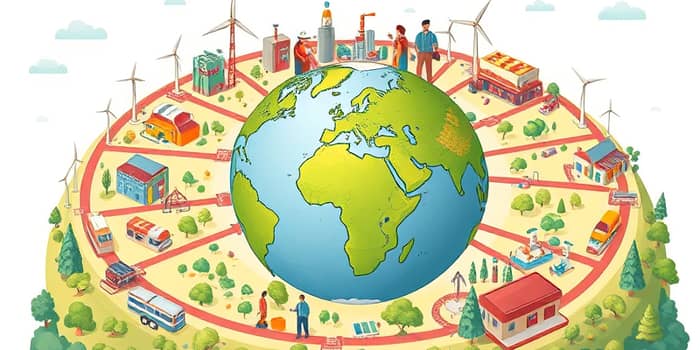
In an era marked by climate urgency and shifting consumer values, businesses face a pivotal choice: continue with traditional practices or embrace sustainability as a core strategy. Investing in ethical production and supply chain transparency is no longer optional—it’s a long-term survival imperative and a source of competitive advantage. This article explores how integrating environmental, social, and governance (ESG) principles into every step of production fuels resilience, builds trust, and unlocks new growth.
By weaving together the latest trends, case studies, practical insights, and statistics, we’ll guide organizations on a path toward minimize negative impacts and enhance ethical practices while meeting rising stakeholder expectations.
At its core, a sustainable supply chain integrates environmental, social, and governance considerations into sourcing, manufacturing, and distribution. It prioritizes fair labor, human rights protection, transparency, and safe working conditions alongside low-impact operations.
Ethical production further demands accountability at every tier, from raw material extraction to the final consumer. It means suppliers are audited for labor standards, emissions are tracked rigorously, and communities impacted by sourcing are respected and supported.
Market forces, regulatory frameworks, and evolving customer values converge to push sustainability into the boardroom. Four core drivers lead the transformation:
Beyond ethics, sustainability initiatives deliver measurable cost savings and resilience. Companies deploying renewable energy, circular economy models, and AI-driven optimization reap significant returns. Diversifying suppliers and implementing multi-shoring strategies cushions against geopolitical and environmental shocks.
Scope 3 emissions—those generated by third-party suppliers—constitute roughly 75% of a company’s carbon footprint. Yet 70% of businesses lack the data transparency to measure or report these indirect impacts fully. Addressing Scope 3 emissions unlocks significant environmental gains and aligns organizations with emerging frameworks like the Corporate Sustainability Due Diligence Directive (CSDDD).
By collaborating with suppliers on emissions tracking and sustainable practices, companies transform risk into opportunity, turning supply chain challenges into a competitive edge.
Modern digital tools underpin every step of a sustainable supply chain. Traceability software replaces manual logs, offering real-time analytics on resource use and emissions. AI drives better demand forecasting, predictive maintenance, and risk detection, delivering dramatic efficiency gains.
Investments in Blockchain ensure product provenance and tamper-proof records. Internet of Things sensors monitor conditions during transport, reducing spoilage and carbon output. Together, these innovations form the backbone of AI-driven process improvements in supply chains.
Industry pioneers demonstrate what’s achievable when sustainability guides every decision:
Patagonia has set benchmarks through its comprehensive supply chain environmental responsibility program, reducing greenhouse gases, optimizing water stewardship, and sourcing ethically.
L’Oréal achieved 97% renewable energy use by 2024, imposed SBTi targets on suppliers, and works to verify sustainable sourcing for key crops by 2030.
Danone and IKEA champion regenerative agriculture and deep supplier partnerships, aiming for 100% verified sustainable sourcing and investing in ecosystem restoration projects worldwide.
Governments and industry bodies are tightening rules on environmental and social performance. The EU’s Carbon Border Adjustment Mechanism (CBAM) introduces tariffs on high-emission imports, while the CSDDD mandates systematic measurement and reporting on impacts throughout value chains.
Companies that proactively align with these frameworks avoid penalties, gain market access, and strengthen stakeholder trust.
Consumers wield substantial influence. 62% of remote workers now prefer eco-conscious brands versus 50% of office-based buyers. A majority express willingness to pay premiums for sustainability, driving companies to embed ethical production into their brand stories.
Transparent labeling, third-party certifications, and engaging storytelling help bridge perceptions that sustainable goods are unaffordable.
Despite progress, hurdles remain. Data gaps hinder full emissions accounting, especially across complex, multi-tiered supplier networks. Implementation costs for new technologies and processes can deter smaller players.
Labor rights enforcement varies globally, making consistent oversight difficult. Companies must invest in supplier training and auditing to ensure fair wages, safe conditions, and compliance with evolving standards.
The next decade will see sustainability move from compliance to core strategy. Companies that invest in ethical production and resilient, transparent supply chains will reap dividends in risk mitigation, brand loyalty, and operational efficiency.
By embracing renewable energy, circular economy models, and cutting-edge digital tools, businesses can achieve both profit and purpose. The journey demands collaboration—from executives to suppliers and consumers—but the rewards are profound: a healthier planet, stronger communities, and enduring growth.
It’s time to transform supply chains into engines of positive impact. Organizations ready to innovate, measure rigorously, and champion ethical practices will lead the way toward a sustainable future—for people, planet, and profit.
References





